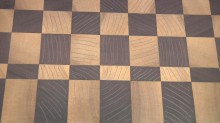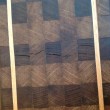Why Did My Cutting Board Split?
Video - December 14, 2015
Updates
I don’t know if this ever happens to you, but sometimes my tools just get out of whack and start to sound funny. Take a listen and let me know if you have any advice.
Why Did My Cutting Board Split?
George Cook wrote in and asked,
My first attempt at an end grain cutting board was OK but I need to fine tune. My biggest problem is that two weeks after I finished I have some large cracking. The wood was dry and the kitchen environment isn’t all that different. I used ironwood and oak. The board is about 1 1/4″ thick sealed with mineral oil. Any clues as to how to prevent this?
There are two things working against us with end grain cutting boards. The first is using multiple wood species. Not every cutting board is made from multiple species but most of them are as they tend to look cooler that way. But each species has its own wood movement properties when exposed to moisture. So by mixing multiple species, each of the little squares is moving at a slightly different rate which leads to internal stress in the board.
 The second issue has to do with grain direction. Many end grain boards end up with the grain going every which way. But as we know, wood moves most across the grain so if some are the pieces are running one way and the others are running perpendicular to that, we can once again end up with lots of internal stress.
The second issue has to do with grain direction. Many end grain boards end up with the grain going every which way. But as we know, wood moves most across the grain so if some are the pieces are running one way and the others are running perpendicular to that, we can once again end up with lots of internal stress.
So does this mean all end grain cutting boards are doomed to fail? Not at all. In fact most of them will do just fine as long as they are seasoned well and aren’t exposed to large amounts of moisture repeatedly. But understanding these two causes of internal stress can help you stack the cards in your favor for a successful long-lasting cutting board.
Want to make the cutting board I showed in this video? Check this out!
Transcription from Video – Today we’re gonna talk about movement issues in cutting boards, like this one. Mmm, smells like onions. But first, I was hoping you might be able to help me out with a small problem I have. For some reason in the last week, my tools have been making some really unusual sounds. As you can see, it’s a pretty embarrassing problem so if you have any suggestions, let me know, thewoodwhisperer.com/contact. Let’s check our email. George Coke wrote in, and he says my first attempt at an end-grain cutting board was okay, but I need to fine tune. My biggest problem was about two weeks after I finished, I have some large cracking. The wood was dry, and the kitchen environment isn’t all the different. I used iron wood and oak. Board is about an inch and quarter thick, sealed with mineral oil. Any clues as to how to prevent this? Now the thing to remember with end grain cutting boards is there’s a good possibility of movement problems, for a couple of reasons. First of all, we tend to use more than one species of wood. ‘Cause it looks cool, I’ve seen as many as four or five species in one board. But each wood species has its own wood movement properties, so when it’s exposed to water or humidity, they might move at different rates. Making the whole board out of balance, and there could be potential problems. The other thing has to do with all these little pieces, and the potential for the grain direction to be going the wrong way. One of our earliest project videos was this cutting board. In fact, I affectionately refer to it as the cutting board that launched 1000 cutting boards. Anyway take a look at the grain direction, I’ve just marked with a pencil, and you can see how it’s completely in conflict. We’ve got pieces running in both directions. Right, ideally, if we could have them all running in the same direction, there’s a better chance that this board is gonna maintain stability throughout the years. Now let’s take a close look at George’s cutting board to see if we can identify exactly what went wrong. First of all, cool idea for a cutting board. The grain direction here doesn’t look all that bad, as most of his pieces are oriented the same way, but there is a glaringly obvious problem. The maple strips. The squares in the board will expand across the length and width. The strips won’t expand much at all across either the length or width. So, we’ve got something that wants to move attached to something that doesn’t want to move. The end result is internal stress. That stress will always find the weakest link in the chain, splitting with the grain, as well as at the joints. So a reasonable solution here, to get the same look, would be to make those strips from end grain as well. Now of course you have to incorporate it into the design, and they would be made of multiple pieces going across the length of the board, but they’re more likely to be stable if the grain is running vertical, and becomes end grain as well. So you’re probably wondering if this means that all those beautiful cutting boards you see people making are eventually going to self destruct. No, they’re not. A lot of them are gonna be perfectly fine. Now the bottom line is you just wanna stack the cards in your favor, right. If the board is kept well, and people aren’t soaking it in water repeatedly, it’s probably gonna be fine, but if you’ve made an end grain board, and you followed all the rules, it’s still may be problematic, that’s just the nature of end grain boards. But following those rules stacks the cards in your favor for a successful project that will last for years to come. Well thanks for watching everybody and if you wanna submit a question for the show, go to http://thewoodwhisperer.com/contact. Now, I’ve gotta go sand out some pencil marks.




